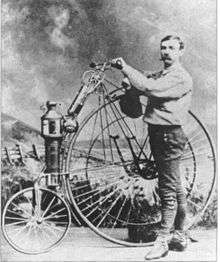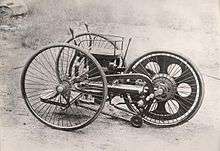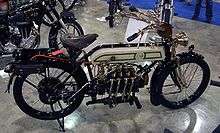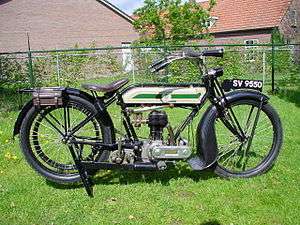History of the motorcycle
The history of the motorcycle begins in the second half of the 19th century. Motorcycles are descended from the "safety bicycle," a bicycle with front and rear wheels of the same size and a pedal crank mechanism to drive the rear wheel.[1] Despite some early landmarks in its development, the motorcycle lacks a rigid pedigree that can be traced back to a single idea or machine. Instead, the idea seems to have occurred to numerous engineers and inventors around Europe at around the same time.
Early steam-powered cycles

In the 1860s Pierre Michaux, a blacksmith in Paris, founded 'Michaux et Cie' ("Michaux and company"), the first company to construct bicycles with pedals called a velocipede at the time, or "Michauline".[2] The first steam powered motorcycle, the Michaux-Perreaux steam velocipede, can be traced to 1867, when Pierre's son Ernest Michaux fitted a small steam engine to one of the 'velocipedes'.[3]
The design went to America when Pierre Lallement, a Michaux employee who also claimed to have developed the prototype in 1863, filed for the first bicycle patent with the US patent office in 1866.[4] In 1868 an American, Sylvester H. Roper of Roxbury, Massachusetts, developed a twin-cylinder steam velocipede, with a coal-fired boiler between the wheels. Roper's contribution to motorcycle development ended suddenly when he died demonstrating one of his machines in Cambridge, Massachusetts on June 1, 1896.[3]
Also in 1868, a French engineer Louis-Guillaume Perreaux patented a similar steam powered single cylinder machine, the Michaux-Perreaux steam velocipede, with an alcohol burner and twin belt drives, which was possibly invented independently of Roper's. Although the patent is dated 1868, nothing indicates the invention had been operable before 1871.[3]
In 1881, Lucius Copeland of Phoenix, Arizona designed a much smaller steam boiler which could drive the large rear wheel of an American Star high-wheeler at 12 mph. In 1887 Copeland formed the Northrop Manufacturing Co. to produce the first successful 'Moto-Cycle' (actually a three-wheeler).[3]
Experimentation and invention

The very first commercial design for a self-propelled bicycle was a three-wheel design called the Butler Petrol Cycle, conceived of and built by Edward Butler in England in 1884.[5] He exhibited his plans for the vehicle at the Stanley Cycle Show in London in 1884, two years earlier than Karl Benz invented his first automobile who is generally recognized as the inventor of the modern automobile. Butler's vehicle was also the first design to be shown at the 1885 International Inventions Exhibition in London.
The vehicle was built by the Merryweather Fire Engine company in Greenwich, in 1888.[6] the Butler Petrol Cycle (first recorded use of the term)[6] It was a three-wheeled vehicle, with the rear wheel directly driven by a 5/8hp (466W) 600 cc (40 in3; 2¼×5-inch {57×127-mm})[6] flat twin four stroke engine (with magneto ignition replaced by coil and battery),[6] equipped with rotary valves and a float-fed carburettor (five years before Maybach),[6] and Ackermann steering,[7] all of which were state of the art at the time. Starting was by compressed air.[6] The engine was liquid-cooled, with a radiator over the rear driving wheel. Speed was controlled by means of a throttle valve lever. No braking system was fitted; the vehicle was stopped by raising and lowering the rear driving wheel using a foot-operated lever; the weight of the machine was then borne by two small castor wheels. The driver was seated between the front wheels.[6] It wasn't, however, a commercial success, as Butler failed to find sufficient financial backing.

Another early internal combustion, petroleum fueled motorcycle was the Petroleum Reitwagen. It was designed and built by the German inventors Gottlieb Daimler and Wilhelm Maybach in Bad Cannstatt, Germany in 1885.[8] This vehicle was unlike either the safety bicycles or the boneshaker bicycles of the era in that it had zero degrees of steering axis angle and no fork offset, and thus did not use the principles of bicycle and motorcycle dynamics developed nearly 70 years earlier. Instead, it relied on two outrigger wheels to remain upright while turning.[9] The inventors called their invention the Reitwagen ("riding car"). It was designed as an expedient testbed for their new engine, rather than a true prototype vehicle.[10][11]
First commercial products
In the decade from the late 1880s, dozens of designs and machines emerged, particularly in Germany and in England, and soon spread to America.[12] During this early period of motorcycle history there were many manufacturers, since bicycle makers were adapting their designs for the new internal combustion engine.

In 1894 Hildebrand & Wolfmüller became the first series production motorcycle, and the first to be called a "motorcycle" (German: Motorrad).[10][11][13][14] However, only a few hundred examples of this motorcycle were ever built. The first instance of the term "motor cycle" also appears in English the same year in materials promoting machines developed by E.J. Pennington,[15] although Pennington's motorcycles never progressed past the prototype stage.[16]
Excelsior Motor Company, originally a bicycle-manufacturing company based in Coventry in Warwickshire (England), began production of their first motorcycle model in 1896, available for purchase by the public. The first production motorcycle in the US was the Orient-Aster, built by Charles Metz in 1898 at his factory in Waltham, Massachusetts.
In 1898, Peugeot Motocycles presents at the Paris Motorshow the first motorcycle equipped with a Dion-Bouton motor. Peugeot Motocycles remains the oldest motorcycle manufacturer in the world.
In the early period of motorcycle history, many producers of bicycles adapted their designs to accommodate the new internal-combustion engine. As the engines became more powerful and designs outgrew the bicycle origins, the number of motorcycle producers increased. Many of the nineteenth-century inventors who worked on early motorcycles often moved on to other inventions. Daimler and Roper, for example, both went on to develop automobiles.
At the turn of the 20th century the first major mass-production firms emerged.

In 1901 English quadricycle- and bicycle-maker Royal Enfield introduced its first motorcycle, with a 239 cc engine mounted in the front and driving the rear wheel through a belt. In 1898 English bicycle-maker Triumph decided to extend its focus to include motorcycles, and by 1902 the company had produced its first motorcycle—a bicycle fitted with a Belgian-built engine. A year later it was the largest motorcycle-manufacturer, with an annual production of over 500 units. Other British firms included Norton and Birmingham Small Arms Company who began motorbike production in 1902 and 1910, respectively.[17]
In 1901 the Indian Motocycle Manufacturing Company, which had been founded by two former bicycle-racers, designed the so-called "diamond framed" Indian Single, whose engine was built by the Aurora Firm in Illinois per Indian's specifications. The Single was made available in the deep blue. Indian's production was up to over 500 bikes by 1902, and would rise to 32,000, its best ever, in 1913.[18][19] Indian produced over 20,000 bikes per year.[20] The oldest surviving Russian-manufactured motorcycle, the Rossiya, dates from 1902.[21] The American company Harley-Davidson started producing motorcycles in 1903.
During this period, experimentation and innovation were driven by the popular new sport of motorcycle racing, with its powerful incentive to produce tough, fast, reliable machines. These enhancements quickly found their way to the public's machines.[12]
Chief August Vollmer of the Berkeley, California Police Department is credited with organizing the first official police motorcycle-patrol in the United States in 1911.[22] By 1914, motorcycles were no longer just bicycles with engines; they had their own technologies, although many still maintained bicycle elements, like the seats and suspension.
The First World War

During the First World War, motorbike production was greatly ramped up for the war effort to supply effective communications with front line troops. Messengers on horses were replaced with dispatch riders on motorcycles carrying messages, performing reconnaissance personnel and acting as a military police. American company Harley-Davidson was devoting over 50% of its factory output toward military contract by the end of the war. The British company Triumph Motorcycles sold more than 30,000 of its Triumph Type H model to allied forces during the war. With the rear wheel driven by a belt, the Model H was fitted with a 499 cc air-cooled four-stroke single-cylinder engine. It was also the first Triumph not to be fitted with pedals, so was a true motorcycle.[23]
The Model H in particular, is regarded by many as having been the first "modern motorcycle".[24] Introduced in 1915 it had a 550cc side-valve four-stroke engine with a three-speed gearbox and belt transmission. It was so popular with its users that it was nicknamed the "Trusty Triumph."[25]
Postwar

Postwar
By 1920, Harley-Davidson became the largest manufacturer,[26] with their motorcycles being sold by dealers in 67 countries.[27][28]
Amongst many British motorcycle manufacturers Chater-Lea with its twin-cylinder models followed by its large singles in the 1920s stood out. Initially, using converted a Woodmann-designed OHV Blackburne engine it became the first 350 cc to exceed 100 mph (160 km/h), recording 100.81 mph (162.24 km/h) over the flying kilometre during April 1924.[7] Later, Chater-Lea set a world record for the flying kilometre for 350 cc and 500 cc motorcycles at 102.9 mph (165.6 km/h) for the firm. Chater-Lea produced variants of these world beating sports models and became popular among racers at the Isle of Man TT. Today, the firm is probably best remembered for its long-term contract to manufacture and supply AA Patrol motorcycles and sidecars.
By the late 1920s or early 1930s, DKW in Germany took over as the largest manufacturer.[29][30][31] BMW motorcycles came on the scene in 1923 with a shaft drive and an opposed-twin or "boxer" engine enclosed with the transmission in a single aluminum housing.
By 1931, Indian and Harley-Davidson were the only two American manufacturers producing commercial motorcycles.[32] This two-company rivalry in the United States remained until 1953, when the Indian Motorcycle factory in Springfield, Massachusetts closed and Royal Enfield took over the Indian name.[33]
There were over 80 different makes of motorcycle available in Britain in the 1930s, from the familiar marques like Norton, Triumph and AJS to the obscure, with names like New Gerrard, NUT, SOS, Chell and Whitwood,[34] about twice as many motorcycle makes competing in the world market during the early 21st century.
In 1937, Joe Petrali set a new land speed record of 136.183 mph (219.165 km/h) on a modified Harley-Davidson 61 cubic inch (1,000 cc) overhead valve-driven motorcycle.[32] The same day, Petrali also broke the speed record for 45 cubic inch (737 cc) engine motorcycles.
In Europe, production demands, driven by the buildup to World War II, included motorcycles for military use, and BSA supplied 126,000 BSA M20 motorcycles to the British armed forces, starting in 1937 and continuing until 1950. Royal Enfield also produced motorcycles for the military, including a 125 cc lightweight motorcycle that could be dropped (in a parachute-fitted tube cage) from an aircraft.
After World War II
After the World War II, some American veterans found a replacement for the camaraderie, excitement, danger and speed of life at war in motorcycles. Grouped into loosely organized clubs, motorcycle riders in the US created a new social institution—the motorcyclists or "bikers"—which was later skewed by the "outlaw" persona Marlon Brando portrayed in the 1953 film The Wild One.[35]
In Europe, on the other hand, post-war motorcycle producers were more concerned with designing practical, economical transportation than the social aspects, or "biker" image.[35] Italian designer Piaggio introduced the Vespa in 1946, which experienced immediate and widespread popularity. Imports from the UK, Italy and Germany, thus found a niche in US markets that American bikes did not fill.
The BSA Group purchased Triumph Motorcycles in 1951 to become the largest producer of motorcycles in the world claiming "one in four". The German NSU was the largest manufacturer from 1955 until 1959 when Honda became the largest manufacturer.[36][37]
British manufacturers Triumph, BSA, and Norton retained a dominant position in some markets until the rise of the Japanese manufacturers, led by Honda, in the late 1960s and early 1970s. The role of the motorcycle shifted in the 1960s, from the tool of a life to a toy of a lifestyle. It became part of an image, of status, a cultural icon for individualism, a prop in Hollywood B-movies.[12]
The motorcycle also became a recreational machine for sport and leisure, a vehicle for carefree youth, not essential transportation for the mature family man or woman, and the Japanese were able to produce modern designs more quickly, more cheaply, and of better quality than their competitors. Their motorbikes were more stylish and more reliable, so the British manufacturers fell behind as mass-market producers.
Honda, which was officially founded in Japan on September 24, 1948, introduced their SOHC inline-four engine CB750 in 1969, which was inexpensive and immediately successful. It established the across-the-frame-four engine configuration as a design with huge potential for power and performance. Shortly after the introduction of the SOHC, Kawasaki demonstrated the potential of the four-stroke four-cylinder engine with the introduction of the KZ900.
Suzuki, Kawasaki and the Yamaha each started producing motorcycles in the 1950s. Meanwhile, the sun was setting on British dominion over the big-displacement motorbike market.
Japanese dominance
The excellence of Japanese motorcycles caused similar effects in all Western markets: many Italian bike firms either went bust or only just managed to survive. As a result, BMW's worldwide sales sagged in the 1960s, but came back strongly with the introduction of a completely redesigned "slash-5" series for model year 1970.
From the 1960s through the 1990s, small two-stroke motorcycles were popular worldwide, partly as a result of the pioneering work of the East German Daniel Zimmermann (rotary disc valve) and MZ's Walter Kaaden who developed the two-stroke expansion chamber in the 1950s. These ideas were taken up by Suzuki when Ernst Degner, the MZ engineer and rider, defected to the West on 13 September 1961 after retiring from the 125cc Swedish Grand Prix at Kristianstad. Degner, an excellent engineer, immediately joined Suzuki and his knowledge became their technology springboard.
Harley-Davidson in the US at the time suffered from the same problems as the European firms, but its unique product range, American tariff laws and nationalism-driven customer loyalty allowed it to survive. One alleged flaw, however, was retaining the characteristic Harley-Davidson 45° engine vee-angle, which causes excess vibration as well as the loping Harley-Davidson sound.
A factory full fairing was introduced by BMW motorcycle in the R100RS of 1977, the first factory fairing produced in quantity.[38] In 1980, BMW stimulated the "adventure touring" category of motorcycling with its dual-sport model, the R80G/S. In 1988, BMW was the first motorcycle manufacturer to introduce anti-lock-brakes (ABS) on its sporting K100RS-SE and K1 models.
The present

Today the Japanese manufacturers, Honda, Kawasaki, Suzuki, and Yamaha dominate the large motorcycle industry, although Harley-Davidson still maintains a high degree of popularity, particularly in the United States.
Recent years have seen a resurgence in the popularity around the world of many other motorcycle brands, including BMW, Triumph and Ducati, and the emergence of Victory as a second successful mass-builder of big-twin American cruisers.
In November 2006, the Dutch company E.V.A. Products BV Holland announced that the first commercially available diesel-powered motorcycle, its Track T-800CDI, achieved production status.[39] The Track T-800CDI uses an 800 cc three-cylinder Daimler Chrysler diesel engine. However, other manufacturers, including Royal Enfield, had been producing diesel-powered bikes since at least 1965.[40]
In the developing world

There is a large demand for small, cheap motorcycles in the developing world, and many of the firms meeting that demand now also compete in mature markets, such as China's Hongdou which makes a version of Honda's venerable CG125.[41]
Motorcycle taxis are commonplace in the developing world. Scooters, mopeds and motorcycles offer a fast, cheap and risky way around snarled traffic and scarce mass transit, as they can easily squeeze through jams.[42]
The first ethanol flex fuel motorcycle in the world was launched to the Brazilian market by Honda in March 2009, the CG 150 Titan Mix[43][44] During the first eight months after its market launch the CG 150 Titan Mix had captured a 10.6% market share, and ranking second in sales of new motorcycles in the Brazilian market in 2009.[45] In September 2009, Honda launched a second flexible-fuel motorcycle,[46] and by December 2010 both Honda flexible-fuel motorcycles had reached cumulative production of 515,726 units, representing an 18.1% market share of the Brazilian new motorcycle sales in that year.[47][48] As of January 2011 there were four flex-fuel motorcycle models available in the market,[49] and production reached the one million milestone in June 2011.[47][48][50]
See also
Further reading
Early history and use in the United Kingdom
- Pennell, Joseph (February 8, 1901). "Some Experiences Of Motor Bicycles". Journal of the Society of Arts. XLIX (2, 516). Retrieved 2009-08-15.
- Hiscox, Gardner Dexter (1902). The Automobile: A Practical Treatise On The Construction Of Modern Motor Cars Steam, Petrol, Electric And Petrol-Electric: Chapter XXI. Motor Bicycles (1903 ed.). London: Cassell And Company, Limited. pp. 751–763. Retrieved 2009-08-15.
- Lavergne, Gerard (1902). The Automobile: Its Construction And Management (Various Chapters). London: Cassell And Company, Limited. Retrieved 2009-08-15.
- Wilson, A. J. (1903). Motor Cycles And How To Manage Them, 6th ed. London: Iliffe & Sons Limited. Retrieved 2009-08-15.
Early history and use in the United States
- Lockert, Louis (1899). Petroleum Motor-Cars: Chapter VIII "Motor Bicycles". New York: D. Van Nostrand Company. pp. 64–75. Retrieved 2009-08-15.
- "The Automobile Bicycle". The Literary Digest. XIX (16): 463–464. October 14, 1899. Retrieved 2009-08-15.
- Hiscox, Gardner Dexter (1900). Horseless Vehicles, Automobiles, Motor Cycles Operated By Steam, Petrol, Electric And Petrol-Electric: Chapter XI. Automobile Bicycles And Tricycles. New York: Munn & COmpany. pp. 175–215. Retrieved 2009-08-15.
- "Interesting Notes. Single Motor Bicycles". The School Journal. LX (22): 632. June 2, 1900. Retrieved 2009-08-15.
- Krarup, M.C. (November 1900). "The Field For Motorcycles: Motorcycling Vs. Motoring". XXXVII (2): 207–212. Retrieved 2009-08-15. Cite journal requires
|journal=(help) - Bill, L. H. (August 1902). "The Poor Man's Automobile". Overland Monthly, and Out West Magazine. XL (2): 197–198. Retrieved 2009-08-15.
- Burr, H. Walter (December 1902). "Up Mount Hamilton On A Motor Cycle". XL (6): 556–561. Cite journal requires
|journal=(help) - "Possibilities of the Motorcycle". The Automobile. XIII (4): 123. July 27, 1903. Retrieved 2009-08-15.
- Hiscox, Gardner Dexter (1904). Mechanical Appliances, Mechanical Movements And Novelties Of Construction: Road And Vehicle Devices, Types Of Motor Bicycles. New York: The Norman W. Henley Publishing Company. pp. 215–216. Retrieved 2009-08-15.
- "Motor Bicycles for Medical Men". The Medical World. XXIII (10). October 1905. Retrieved 2009-08-15.
- Cummings, C. E. (February 1906). "An Idyl Of The Tireless Bike". Recreation. XXIV (2): 127–130. Retrieved 2009-08-15.
- Bashore, S. D. (July 1906). "The Motor Cycle For Physicians". The Texas State Journal of Medicine. II (3): 92–93. Retrieved 2009-08-15.
- "Mail Collection By Motor Van". The Commercial Vehicle. III (7). July 1908. Retrieved 2009-08-15.
An experiment is being conducted by the Post-office ... with the use of a motorcycle van ... of the "Indian" type
- "Development Of The Motor Cycle Van: Increasing Use Of This Type Of Light Package Delivery Motor Vehicle Noted Both Here And Abroad". The Commercial Vehicle. III (10): 227–228. October 1908. Retrieved 2009-08-15.
References
- "The Past - 1800s: First motorcycle". The History and Future of Motorcycles and motorcycling - From 1885 to the Future, Total Motorcycle Website. Retrieved 2007-06-28.
- Michauline
- Burgess Wise, David (1973). Historic Motor Cycles. Hamlyn Publishing Group Limited. ISBN 0-600-34407-X.
- Fiedler, David. "The Boneshaker - Invented by Michaux and Lallement". About.com. Retrieved 23 September 2010.
- "motorcycle (vehicle)". Encyclopædia Britannica.
- G.N. Georgano (2002). Early and Vintage Years, 1885-1930: The Golden Era of Coachbuilding. Mason Crest Publishers. p. 22.
- G.N. Georgano, p.20 cap.
- "The Past – 1800s: First motorcycle". The History and Future of Motorcycles and motorcycling – From 1885 to the Future, Total Motorcycle Website. Retrieved 28 June 2007.
- Lienhard, John H. (2005). Inventing Modern: Growing Up with X-Rays, Skyscrapers, and Tailfins. Oxford University Press US. pp. 120–121. ISBN 0-19-518951-5.
- Setright, L.J.K. (1979). The Guinness book of motorcycling facts and feats. Guinness Superlatives. pp. 8–18. ISBN 978-0-85112-200-7.
- Falco, Charles M.; Guggenheim Museum Staff (1998). "Issues in the Evolution of the Motorcycle". In Krens, Thomas; Drutt, Matthew (eds.). The Art of the Motorcycle. Harry N. Abrams. pp. 24–31. ISBN 0-89207-207-5.
- Ian Chadwick (June 30, 2001). "An overview of the British motorcycle industry and its collapse". British Motorcycle Manufacturers. Retrieved 2007-06-28.
- Kresnak, Bill (2008). Motorcycling for Dummies. Hoboken, New Jersey: For Dummies, Wiley Publishing. ISBN 978-0-470-24587-3.
- "Brief History of the Marque: Hildebrand & Wolfmuller". Hildebrand & Wolfmuller Motorad, European Motorcycle Universe. Retrieved 28 June 2007.
- "Wagner,Herbert "The World's First Motorcycle Origin of the Word and Device"". Archived from the original on 2014-07-04. Retrieved 2014-03-18.
- Chadwick, Ian. "Pennington" (in list of) British motorcycle manufacturers P:, June 6, 2003, retrieved March 18, 2014.
- "History of Motorbikes".
- Walker, Mick (2006). Motorcycle: Evolution, Design, Passion. JHU Press. ISBN 978-0-8018-8530-3.
- George Hendee. The AMA Motorcycle Hall of Fame Museum. Archived from the original on September 10, 2009. Retrieved 8 August 2009.
- Youngblood, Ed (June 2001). "The Rise and Fall". American Motorcyclist. 55 (6). American Motorcyclist Assoc.
-
Kelly, Maurice A. (2009). "2: The manufacturers". Russian Motor Vehicles: The Czarist Period 1784 to 1917. Veloce Publishing Ltd. p. 56. ISBN 9781845842130. Retrieved 2017-10-31.
[...] a Rossiya Motorcycle of 1902 [...] is the oldest Russian self-propelled road vehicle in existence today.
- "Our History". Berkeley Police Department Online, City of Berkeley, CA. Retrieved 2007-06-28.
- "Triumph history". Archived from the original on December 29, 2008. Retrieved 2009-05-20.
- "Triumph Motorcycle History". Archived from the original on 2015-03-21. Retrieved 2013-11-18.
- "Triumph Motorcycles timeline".
- "History of Harley-Davidson Motor Company".
- Prashad, Sharda (16 April 2006). "HOG WILD; U of T professor Brendan Calder is one of the legions of baby boomers who have helped to ensure the success of the Harley-Davidson brand name, not to mention its bottom line". Toronto Star. Toronto, Ont. p. A.16.
- Cato, Jeremy (8 August 2003). "Harley-Davidson at 100". The Vancouver Sun. Vancouver, B.C. p. E.1.Fro.
- Vance, Bill (24 April 2009). "Motoring Memories: DKW/Auto Union, 1928–1966". Canadian Driver.
- de Cet, Mirco (2002). The illustrated directory of motorcycles. MotorBooks/MBI Publishing Company. p. 128. ISBN 978-0-7603-1417-3.
- Walker, Mick (1999). Mick Walker's German Racing Motorcycles. Redline Books. p. 61. ISBN 978-0-9531311-2-9.
- "HD History: Timeline - 1930s". Harley-Davidson USA (2001-2007 H-D). Archived from the original on September 28, 2007. Retrieved 2007-06-28.
- "Post 1953 Indian Motorcycle History". www.cycletownusa.com. Archived from the original on July 4, 2007. Retrieved 2007-06-28.
- "British Motorcycles of the 1930s". www.webBikeWorld.com, webWorld International, LLC (2001-2007). Retrieved 2007-06-28.
- "Freedom and Postwar Mobility: 1946-1958". The Art of the Motorcycle, Guggenheim Museum. Retrieved 2014-06-25.
- Grant, Robert M.; Neupert, Kent E. (2003). Cases in contemporary strategy analysis (3rd ed.). Wiley-Blackwell. ISBN 1-4051-1180-1. Retrieved 2010-11-12.
- Johnson, Richard Alan (2005). Six men who built the modern auto industry. MotorBooks International. p. 52. ISBN 0-7603-1958-8. Retrieved 2010-11-12.
- Bill Stermer (January–February 2008). "1977 BMW R100RS". Motorcycle Classics. Retrieved 2009-08-10.
- "The first commercially-available diesel motorcycle". www.Gizmag.com (November 20, 2006). 20 November 2006. Retrieved 2007-06-28.
- "Diesel motorbikes". Journey to Forever. Retrieved 2007-06-28.
- "Hongdou Group: Manufacturer & Exporter . . ". International Department, Hongdou Motorcycle Co. Ltd. Archived from the original on 2007-06-07. Retrieved 2007-06-28.
- Daniel Michaels. "Two-Wheel Taxis Tap Upscale Market in Paris". Startup Journal - Enterprise, The Wall Street Journal - Center for Entrepreneurs (2007 Dow Jones & Company, Inc.). Archived from the original on 2006-03-23. Retrieved 2007-06-28.
- Agencia EFE (2003-03-11). "Honda lançará moto flex ainda neste mês no Brasil" (in Portuguese). Folha Online. Retrieved 2003-03-11.
- "Honda lança no Brasil primeira moto flex do mundo" (in Portuguese). UNICA. 2003-03-11. Archived from the original on 2009-08-04. Retrieved 2003-03-11.
- ABRACICLO (September 2009). "Vendas 2009" (PDF) (in Portuguese). Archived from the original (PDF) on November 22, 2009. Retrieved 2010-01-26.
- "Nova Honda NXR 150 Bros Mix é a 1ª On-Off Road com tecnologia bicombustível do Brasil" (in Portuguese). MotoDriver. 2009-09-17. Archived from the original on September 29, 2009. Retrieved 2010-02-10.
- "Produção Motocicletas 2010" (PDF) (in Portuguese). ABRACICLO. Retrieved 2011-02-15.
- Abraciclo (2010-01-27). "Motos flex foram as mais vendidas em 2009 na categoria 150cc" (in Portuguese). UNICA. Archived from the original on 2012-12-05. Retrieved 2010-02-10.
- "Com novo modelo flex, mais de metade da produção da Honda será bicombustível" (in Portuguese). UNICA, Brazil. 2011-01-12. Retrieved 2011-03-18.
- "Produção Motocicletas 2011" (PDF) (in Portuguese). ABRACICLO. Retrieved 2011-08-02. Production through June 2011.
